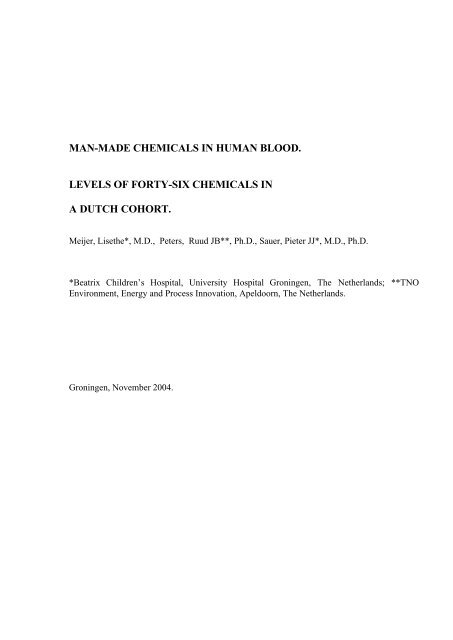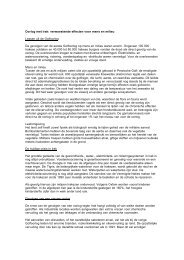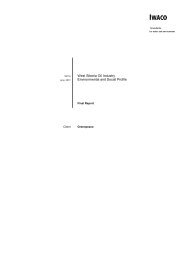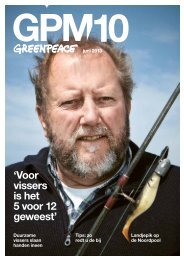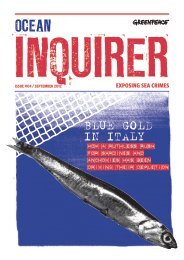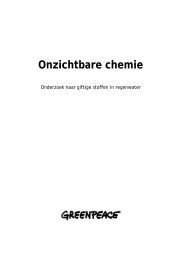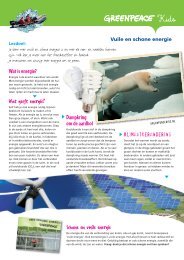man-made chemicals in human blood. levels of - Greenpeace ...
man-made chemicals in human blood. levels of - Greenpeace ...
man-made chemicals in human blood. levels of - Greenpeace ...
Create successful ePaper yourself
Turn your PDF publications into a flip-book with our unique Google optimized e-Paper software.
MAN-MADE CHEMICALS IN HUMAN BLOOD.<br />
LEVELS OF FORTY-SIX CHEMICALS IN<br />
A DUTCH COHORT.<br />
Meijer, Lisethe*, M.D., Peters, Ruud JB**, Ph.D., Sauer, Pieter JJ*, M.D., Ph.D.<br />
*Beatrix Children’s Hospital, University Hospital Gron<strong>in</strong>gen, The Netherlands; **TNO<br />
Environment, Energy and Process Innovation, Apeldoorn, The Netherlands.<br />
Gron<strong>in</strong>gen, November 2004.
Abstract<br />
Hu<strong>man</strong> be<strong>in</strong>gs are cont<strong>in</strong>uously exposed to <strong>man</strong>-<strong>made</strong> <strong>chemicals</strong> <strong>in</strong>troduced <strong>in</strong> the environment.<br />
Studies <strong>in</strong> animals have shown negative health effects <strong>of</strong> some <strong>of</strong> these compounds. Limited<br />
<strong>in</strong>formation is available regard<strong>in</strong>g the <strong>levels</strong> <strong>of</strong> these compounds <strong>in</strong> the hu<strong>man</strong> as well as their potential<br />
health effects.<br />
The aim <strong>of</strong> this study is to measure <strong>blood</strong> <strong>levels</strong> <strong>of</strong> 46 <strong>man</strong>-<strong>made</strong> <strong>chemicals</strong> <strong>in</strong> a random Dutch<br />
population. N<strong>in</strong>ety-one healthy volunteers were <strong>in</strong>cluded, 48 males and 43 females. The age ranged<br />
from 19 till 78 years.<br />
Thirty-six <strong>of</strong> the 46 <strong>chemicals</strong> were detected. Some compounds were detected <strong>in</strong> all <strong>in</strong>dividuals, some<br />
only <strong>in</strong> one <strong>in</strong>dividual. The brom<strong>in</strong>ated flame retardant BDE-153 was detected <strong>in</strong> 76 samples, with a<br />
median <strong>of</strong> 8.0 pg/g. The newer brom<strong>in</strong>ated compounds HBCD and TBBPA were detected <strong>in</strong> 11 and 32<br />
<strong>of</strong> the samples. The phthalates, DEHP and DBP were detected <strong>in</strong> 84 respectively. 68 <strong>of</strong> the samples,<br />
both showed a wide range <strong>of</strong> <strong>levels</strong>. The synthetic musk compounds, AHTN and HHCB, were detected<br />
<strong>in</strong> 88 and 91 samples respectively. Remarkably, Musk Ambrette, which has been banned <strong>in</strong> the<br />
European Union s<strong>in</strong>ce 1995, was still observed <strong>in</strong> 48 samples. Organot<strong>in</strong> compounds were hardly<br />
detected. Bisphenol-A was above detection limit <strong>in</strong> 36 <strong>of</strong> the samples.<br />
We did not observe a correlation between any <strong>of</strong> the <strong>levels</strong> and age, sex, occupation and liv<strong>in</strong>g area.<br />
Only BDE-153 showed a higher level <strong>in</strong> males. Levels <strong>of</strong> <strong>chemicals</strong> belong<strong>in</strong>g to the same group were<br />
related to each other. Relations between the <strong>levels</strong> <strong>of</strong> different groups were found for phthalates and<br />
synthetic musk compounds and for phthalates and Bisphenol-A.<br />
We conclude that the Dutch population is exposed to a variety <strong>of</strong> <strong>man</strong>-<strong>made</strong> <strong>chemicals</strong>. In all <strong>blood</strong><br />
samples <strong>man</strong>-<strong>made</strong> <strong>chemicals</strong> were detected. A wide range <strong>of</strong> <strong>levels</strong> was detected for some compounds.<br />
The most likely explanation is differences <strong>in</strong> exposure, although we were not able to relate these to a<br />
s<strong>in</strong>gle factor. The results <strong>of</strong> this study also show that the <strong>in</strong>troduction <strong>of</strong> any new agent almost<br />
immediately results <strong>in</strong> detectable <strong>levels</strong> <strong>in</strong> the hu<strong>man</strong>, while a reduction <strong>in</strong> production results <strong>in</strong> a<br />
reduction <strong>in</strong> <strong>levels</strong> <strong>in</strong> hu<strong>man</strong>.<br />
Studies are needed regard<strong>in</strong>g the way the hu<strong>man</strong> is exposed to these compounds as well as regard<strong>in</strong>g<br />
potential negative health effects. Studies on other, older environmental contam<strong>in</strong>ants like diox<strong>in</strong>s and<br />
PCBs have shown negative effects <strong>of</strong> these pollutants for hu<strong>man</strong> health. Special emphasis is needed<br />
regard<strong>in</strong>g the effect <strong>of</strong> exposure to a mixture <strong>of</strong> compounds. Animal studies usually evaluate the effect<br />
<strong>of</strong> one s<strong>in</strong>gle agent. Both a reduction <strong>in</strong> the use <strong>of</strong> <strong>man</strong>-<strong>made</strong> <strong>chemicals</strong> as well as studies concern<strong>in</strong>g<br />
the potential negative effects <strong>of</strong> these products for hu<strong>man</strong> health is very much needed.<br />
2
Samenvatt<strong>in</strong>g.<br />
Mensen zijn cont<strong>in</strong>u blootgesteld aan kunstmatig geproduceerde chemische st<strong>of</strong>fen. Dierstudies<br />
tonen aan dat een aantal van deze st<strong>of</strong>fen negatieve gezondheidseffecten kan hebben. Over de<br />
concentraties die aanwezig zijn <strong>in</strong> de lichamen van mensen en over de mogelijke<br />
gezondheidseffecten voor mensen is slechts beperkt <strong>in</strong>formatie beschikbaar.<br />
Doel van deze studie is de concentraties te meten van 46 chemische st<strong>of</strong>fen <strong>in</strong> het bloed van<br />
een willekeurige groep Nederlanders. In de studie zijn 91 vrijwilligers betrokken, 48 <strong>man</strong>nen<br />
en 43 vrouwen. Hun leeftijd varieerde van 19 tot 78 jaar.<br />
Van de 46 chemische st<strong>of</strong>fen waren 36 aantoonbaar. Sommige st<strong>of</strong>fen werden aangetr<strong>of</strong>fen <strong>in</strong><br />
het bloed van alle <strong>in</strong>dividuen, andere slechts <strong>in</strong> één <strong>in</strong>dividu. De broomhoudende vlamvertrager<br />
BDE-153 werd aangetr<strong>of</strong>fen <strong>in</strong> 76 bloedmonsters, met een mediaan van 8,0 pg/g. De nieuwere<br />
broomhoudende vlamvertrages HBCD en TBBPA zijn aangetr<strong>of</strong>fen <strong>in</strong> 11 en 32 monsters. Van<br />
de ftalaten werden DEHP en DBP aangetoond <strong>in</strong> resp. 84 en 68 monsters, waarbij de gehaltes<br />
een grote spreid<strong>in</strong>g lieten zien. De synthetische muskverb<strong>in</strong>d<strong>in</strong>gen AHTN en HHCB werden<br />
aangetr<strong>of</strong>fen <strong>in</strong> resp. 88 en 91 bloedmonsters. Musk ambrette, s<strong>in</strong>ds 1995 verboden <strong>in</strong> de<br />
Europese Unie, werd nog steeds aangetr<strong>of</strong>fen <strong>in</strong> 50% van de monsters. Organot<strong>in</strong>verb<strong>in</strong>d<strong>in</strong>gen<br />
zijn nauwelijks aangetr<strong>of</strong>fen. Bisfenol-A werd aangetoond <strong>in</strong> 36 monsters.<br />
Correlaties tussen de verschillende gehaltes en leeftijd, sekse, beroep en woongebied zijn niet<br />
gevonden. Alleen BDE-153 is bij <strong>man</strong>nen <strong>in</strong> een hoger gehalte aangetr<strong>of</strong>fen. Gehaltes van<br />
chemische st<strong>of</strong>fen die tot dezelfde st<strong>of</strong>groep behoren zijn aan elkaar gerelateerd. Relaties<br />
tussen de gehaltes van verschillende groepen zijn gevonden tussen ftalaten en<br />
muskverb<strong>in</strong>d<strong>in</strong>gen en tussen ftalaten en bisfenol-A.<br />
Samenvattend: de Nederlandse bevolk<strong>in</strong>g staat bloot aan uiteenlopende chemische st<strong>of</strong>fen. In<br />
alle bloedmonsters zijn meerdere van de onderzochte st<strong>of</strong>fen aangetr<strong>of</strong>fen. De gehaltes van<br />
sommige st<strong>of</strong>fen liepen sterk uiteen. De meest voor de hand liggende verklar<strong>in</strong>g is dat de<br />
blootstell<strong>in</strong>gen sterk verschillen, hoewel we de verschillen niet <strong>in</strong> verband konden brengen met<br />
één factor. Uit deze studie blijkt ook dat zodra een nieuwe st<strong>of</strong> wordt geïntroduceerd, deze<br />
vrijwel onmiddellijk aantoonbaar is <strong>in</strong> mensen. Omgekeerd resulteert een verm<strong>in</strong>derde<br />
productie van een st<strong>of</strong> <strong>in</strong> lagere gehaltes <strong>in</strong> mens.<br />
Onderzoek is nodig naar de wijze waarop mensen aan de onderzochte st<strong>of</strong>fen zijn blootgesteld<br />
en naar potentiële negatieve gezondheidseffecten. Studies naar oudere milieuvervuilende<br />
st<strong>of</strong>fen als diox<strong>in</strong>en en PCB’s toonden negatieve effecten aan op de gezondheid van mensen. In<br />
het bijzonder is aandacht nodig voor het effect van blootstell<strong>in</strong>g aan een comb<strong>in</strong>atie van<br />
st<strong>of</strong>fen. Dierstudies onderzoeken meestal slechts het effect van één st<strong>of</strong>. Zeer noodzakelijk zijn<br />
zowel een reductie <strong>in</strong> het gebruik van kunstmatig geproduceerde chemicaliën, als en<br />
onderzoeken naar de potentiële negatieve effecten van deze producten op de gezondheid van<br />
mensen.<br />
3
Introduction.<br />
There is <strong>in</strong>creas<strong>in</strong>g concern regard<strong>in</strong>g the effects <strong>of</strong> the presence <strong>of</strong> <strong>man</strong>-<strong>made</strong> <strong>chemicals</strong> <strong>in</strong> the<br />
environment on hu<strong>man</strong> health. A number <strong>of</strong> these <strong>chemicals</strong>, especially the lipophyllic compounds,<br />
accumulate <strong>in</strong> animal fat and also <strong>in</strong> hu<strong>man</strong> tissues (1,2). The hu<strong>man</strong> is exposed to these <strong>chemicals</strong><br />
through a variety <strong>of</strong> ways. The most important route is food, as the <strong>chemicals</strong> accumulate <strong>in</strong> the food<br />
cha<strong>in</strong> (3). The hu<strong>man</strong> is also exposed through the presence <strong>of</strong> <strong>chemicals</strong> <strong>in</strong> dust and air and by direct<br />
contact. The latter might for <strong>in</strong>stance be important for <strong>chemicals</strong> present <strong>in</strong> cosmetics (4). The work<strong>in</strong>g<br />
environment can cause unusual high <strong>levels</strong> <strong>of</strong> exposure. All these ways <strong>of</strong> exposure can lead to<br />
accumulation <strong>of</strong> these compounds <strong>in</strong> hu<strong>man</strong> tissues.<br />
A number <strong>of</strong> the analyzed <strong>man</strong>-<strong>made</strong> <strong>chemicals</strong> show negative health effects <strong>in</strong> animals (5,6). For<br />
example, endocr<strong>in</strong>e disruptive effects have been described, not only <strong>in</strong> laboratory animals but also <strong>in</strong><br />
wildlife (7). Less is known regard<strong>in</strong>g the effects <strong>of</strong> these compounds on hu<strong>man</strong> health as only a limited<br />
number <strong>of</strong> studies have been done (8,9,10). The hu<strong>man</strong> is exposed to a variable <strong>levels</strong> and comb<strong>in</strong>ation<br />
<strong>of</strong> compounds. Studies <strong>in</strong> animals usually concern s<strong>in</strong>gle compounds. It is impossible to translate the<br />
results <strong>of</strong> these s<strong>in</strong>gle compound studies directly to the situation <strong>in</strong> the hu<strong>man</strong> who is exposed to a<br />
comb<strong>in</strong>ation <strong>of</strong> compounds. The <strong>chemicals</strong> might act synergistically as well as antagonistically.<br />
The objective <strong>of</strong> the present study is to determ<strong>in</strong>e the <strong>levels</strong> <strong>of</strong> forty-six <strong>man</strong>-<strong>made</strong> <strong>chemicals</strong> <strong>in</strong> healthy<br />
volunteers <strong>in</strong> the Netherlands. The groups <strong>of</strong> <strong>chemicals</strong> studied are brom<strong>in</strong>ated flameretardants,<br />
organot<strong>in</strong> compounds, artificial musk compounds, alkylphenols, bisphenol-A and phthalates. We<br />
evaluated whether plasma <strong>levels</strong> <strong>of</strong> different compounds are related to each other. We also evaluated the<br />
relation with age, sex, liv<strong>in</strong>g area, occupation and food <strong>in</strong>take.<br />
Methods.<br />
Healthy volunteers were recruited for this study. The recruitment was done through an advertisement <strong>in</strong><br />
a nationally broadcasted radio program where the purpose and design <strong>of</strong> the study was expla<strong>in</strong>ed.<br />
People <strong>in</strong>terested to participate as a volunteer were asked to send an e-mail. Thirteen hundred and one<br />
volunteers <strong>in</strong>dicated their <strong>in</strong>terest to participate <strong>in</strong> the study.<br />
A stratified sample <strong>of</strong> volunteers was <strong>made</strong> based on the follow<strong>in</strong>g criteria. The Netherlands was<br />
divided, based on population, <strong>in</strong>to 10 areas. From each area two males and two females born before<br />
1960 were randomly selected as well as two males and two females born after 1960. In addition to these<br />
80 volunteers, eleven randomly selected but well-known <strong>in</strong>dividuals from the Netherlands were <strong>in</strong>vited<br />
to participate <strong>in</strong> the study.<br />
After giv<strong>in</strong>g <strong>in</strong>formed consent, the participants were visited at their homes. 60 ml <strong>blood</strong> was taken from<br />
each participant via venipuncture and collected <strong>in</strong> BD-vacuta<strong>in</strong>er tubes. Samples were kept cool<br />
(between 2 0 C and 8 0 C) until delivered at the laboratory with<strong>in</strong> 24 hrs. Thereafter samples were stored<br />
at 4 0 C until analysis. All participants filled <strong>in</strong> two questionnaires. One, custom-<strong>made</strong> questionnaire<br />
conta<strong>in</strong>ed questions regard<strong>in</strong>g the background <strong>of</strong> the participant, <strong>in</strong>clud<strong>in</strong>g age, sex, smok<strong>in</strong>g and<br />
occupation. The use <strong>of</strong> cosmetics was also recorded. A second, previously validated questionnaire<br />
concerned the dietary habits <strong>of</strong> the participants (11).<br />
Analyses.<br />
The laboratory <strong>of</strong> TNO Environment, Energy and Process <strong>in</strong>novation <strong>in</strong> Apeldoorn, The Netherlands,<br />
performed all laboratory analyses. The list <strong>of</strong> <strong>chemicals</strong> that were measured is given <strong>in</strong> table 1.<br />
4
Materials and methods.<br />
Before the start <strong>of</strong> the project, all methods used <strong>in</strong> this study were validated for the analytes under study.<br />
The validation experiments were carried out us<strong>in</strong>g fresh calf’s <strong>blood</strong> and spiked with the analytes <strong>of</strong><br />
<strong>in</strong>terest. The validation study resulted <strong>in</strong> standard operation procedures that were tested on a limited<br />
number <strong>of</strong> hu<strong>man</strong> <strong>blood</strong> samples and subsequently used <strong>in</strong> this study.<br />
Sample pre-treatment.<br />
Upon receipt <strong>of</strong> the whole sample, a sub-sample was collected for the organot<strong>in</strong> analysis. The rema<strong>in</strong><strong>in</strong>g<br />
part was allowed to clot at room temperature for 20 m<strong>in</strong> and centrifuged at 4000 rpm for 15 m<strong>in</strong>. The<br />
serum was transferred <strong>in</strong>to PTFE-capped glass vials and stored at 4°C until further analysis.<br />
Sample analysis. Extraction <strong>of</strong> serum samples.<br />
All glassware used <strong>in</strong> the analyses was cleaned, r<strong>in</strong>sed with deionised water and baked <strong>in</strong> an oven for 16<br />
hours at 280°C prior to use. All solvents were distilled prior to use to achieve low blank results. The<br />
latter was especially important for the determ<strong>in</strong>ation <strong>of</strong> the phthalates.<br />
The serum sample was weighed <strong>in</strong>to a clean glass 60 ml vial. Methanol, 0.1 M HCl and a set <strong>of</strong> <strong>in</strong>ternal<br />
standards (one or more for each group <strong>of</strong> <strong>chemicals</strong>) was added to the sample. The sample was extracted<br />
twice with a hexane-diethyl ether mixture and centrifuged to separate the organic phase. The comb<strong>in</strong>ed<br />
extracts were washed with a 1% KCl-solution and dried with anhydrous sodium sulphate. The extract<br />
was split <strong>in</strong>to two equal parts, A and B.<br />
Bisphenol-A, tetrabromobisphenol-A, alkylphenols and alkylphenol ethoxylates.<br />
Part A <strong>of</strong> the extract was concentrated to a small volume without further purification. Methanol was<br />
added to the extract and the extract was concentrated further to remove all hexane-diethyl ether residues.<br />
The methanol extract was used for the determ<strong>in</strong>ation <strong>of</strong> BPA, TBBPA, NP, OP, NPEO and OPEO. The<br />
f<strong>in</strong>al extracts were analysed with liquid chromatography coupled with mass spectrometry (LC/MS) <strong>in</strong><br />
the selected ion monitor<strong>in</strong>g mode (SIM).<br />
Brom<strong>in</strong>ated flame retardants, phthalates and musk compounds.<br />
Part B <strong>of</strong> the extract was concentrated to a small volume. The extract was purified us<strong>in</strong>g a florisil cleanup<br />
procedure and separate fractions were collected conta<strong>in</strong><strong>in</strong>g the component groups. The purified<br />
extracts were concentrated to a small volume and an <strong>in</strong>jection standard was added. The f<strong>in</strong>al extracts<br />
were analysed with gas chromatography coupled with mass spectrometry (GC/MS) <strong>in</strong> the selected ion<br />
monitor<strong>in</strong>g mode (SIM).<br />
Organot<strong>in</strong> compounds.<br />
The whole <strong>blood</strong> sample was weighed <strong>in</strong>to a 60 ml vial and <strong>in</strong>ternal standards were added. After the<br />
addition <strong>of</strong> a sodium dithiocarbamate solution <strong>in</strong> ethanol, the sample was sonicated, left overnight, and<br />
sonicated once more. The residue was removed and an acetate buffer and a sodium tetra-ethylborate<br />
solution <strong>in</strong> ethanol were added. The mixture was extracted twice with hexane for 30 m<strong>in</strong>utes and<br />
purified us<strong>in</strong>g a silica clean-up procedure. The purified extract was concentrated and an <strong>in</strong>jection<br />
standard was added. The f<strong>in</strong>al extracts were analysed with gas chromatography coupled with mass<br />
spectrometry (GC/MS) <strong>in</strong> the selected ion monitor<strong>in</strong>g mode (SIM).<br />
Identification, quantification and expression <strong>of</strong> results.<br />
The identification <strong>of</strong> analytes was based on correct retention times and qualifier ion ratios, compared to<br />
an external standard. The quantification was based on an external standard analysed together with the<br />
5
samples. The recovery <strong>of</strong> the added <strong>in</strong>ternal standards was used to determ<strong>in</strong>e the perfor<strong>man</strong>ce <strong>of</strong> the<br />
analysis, but not to correct the results <strong>of</strong> the target compounds.<br />
The results <strong>in</strong> this report are expressed <strong>in</strong> pg/g serum (flame retardants) and ng/g serum (other analytes).<br />
The study was approved by the Medical-Ethical Committee <strong>of</strong> the University Hospital Gron<strong>in</strong>gen. All<br />
participants provided written <strong>in</strong>formed consent.<br />
Statistical analysis.<br />
Median (50 th -percentile) and range were determ<strong>in</strong>ed for all compounds. Other percentiles were<br />
calculated to provide additional <strong>in</strong>formation about the shape <strong>of</strong> the distribution. The relation between<br />
<strong>levels</strong> and demographic data was analysed by comparison <strong>in</strong> pairs. The relation between <strong>levels</strong> <strong>of</strong><br />
<strong>in</strong>dividual compounds was analysed by regression analysis. All analyses were done with only the <strong>levels</strong><br />
above detection limit as well as with the non detectables set at 50% <strong>of</strong> the detection limit. The<br />
percentiles are calculated from the results above detection limit.<br />
Results<br />
In total 91 volunteers were <strong>in</strong>cluded <strong>in</strong> the study. The personal data <strong>of</strong> the subjects are given <strong>in</strong> table 2.<br />
Accord<strong>in</strong>g to the study design there were at least 8 participants per area. The age <strong>of</strong> the participants<br />
ranged from 19 to 78 years. There were no significant differences <strong>in</strong> distributions <strong>of</strong> sex, age and<br />
occupation between the groups <strong>in</strong> the different areas.<br />
Of the brom<strong>in</strong>ated flame retardants, BDE-153 was most abundant present and detectable <strong>in</strong> 76 <strong>of</strong> the 91<br />
samples (table 3). BDE-47 was found <strong>in</strong> 40 <strong>of</strong> the samples, BDE-28 and BOG-49 <strong>in</strong> only one sample<br />
while BDE-17 and 85 were not above detection limit <strong>in</strong> any <strong>of</strong> the samples. Of the other flame<br />
retardants identified, BDE-209 (deca-BDE) was found <strong>in</strong> 11 samples, while HBCD and TBBPA were<br />
above detection limits <strong>in</strong> 11 and 32 samples respectively<br />
Overall, concentrations <strong>of</strong> brom<strong>in</strong>ated compounds varied widely; this however was ma<strong>in</strong>ly due to a<br />
small number <strong>of</strong> particularly high <strong>levels</strong> <strong>in</strong> the different compounds. For <strong>in</strong>stances, for BDE-153 about<br />
10% <strong>of</strong> the samples have values <strong>of</strong> more than three times the median, clearly <strong>in</strong>dicat<strong>in</strong>g that they<br />
significantly deviate from the other results. The same is true for BDE-47, -99, -100, -154, -183 and<br />
TBBPA. The organot<strong>in</strong> compounds were only detectable <strong>in</strong> very few samples, while all detectable<br />
<strong>levels</strong> were only just above detection limit (table 4). DBT, MPT, DPT and TPT were not detectable <strong>in</strong><br />
any <strong>of</strong> the samples.<br />
Of the artificial musk compounds, the more recently <strong>in</strong>troduced compounds AHTN and HHCB were<br />
detectable <strong>in</strong> 88 and 91 samples respectively <strong>of</strong> the 91 samples.( Table 5 ) For AHTN, one sample<br />
conta<strong>in</strong>ed more than 10 ng/g, 7 samples between 1 and 2 ng/g while all others conta<strong>in</strong>ed less than 1<br />
ng/g. Detected HHCB concentrations ranged from 0.2 to 9.2 with a median concentration <strong>of</strong> 1.3 ng/g.<br />
Four samples conta<strong>in</strong>ed concentrations <strong>of</strong> 4.3, 6.7, 8.7 and 9.2 ng/g which is more than 3 times the<br />
median HHCB concentration. Surpris<strong>in</strong>gly, <strong>of</strong> the older, nitromusk compounds, musk ambrette was<br />
surpris<strong>in</strong>gly detectable <strong>in</strong> 48 <strong>of</strong> the samples. The other musk compounds were detectable only <strong>in</strong> low<br />
<strong>levels</strong> and <strong>in</strong> very few samples.<br />
Bisphenol-A was the most frequently detected compound <strong>of</strong> the phenolic agents, appear<strong>in</strong>g <strong>in</strong> 36 <strong>of</strong> the<br />
samples at above limits <strong>of</strong> detection (table 6). If BPA was detected about two third <strong>of</strong> the concentrations<br />
were below 2 ng/g. The other third showed concentrations up to 16 ng/g. For NP, detected <strong>in</strong> 16<br />
samples, the distribution is more or less comparable to that <strong>of</strong> BPA.<br />
The phthalates and especially DBP, BzBP and DEHP were detected <strong>in</strong> a majority <strong>of</strong> the samples (table<br />
7). DEHP was present <strong>in</strong> 84 <strong>of</strong> the 91 samples, showed at a remarkably wide range <strong>of</strong> <strong>levels</strong>, from 25 to<br />
5863 ng/g plasma.<br />
6
For none <strong>of</strong> the compounds, except for BDE-153, was a difference between the <strong>levels</strong> <strong>in</strong> males vs<br />
females found. BDE-153 showed a value <strong>of</strong> 23 ± 6 (mean ± SE) pg/g <strong>in</strong> <strong>man</strong> compared to 10 ± 6 pg/g<br />
<strong>in</strong> wo<strong>man</strong> (p
groups. This approach was chosen to obta<strong>in</strong> <strong>in</strong>formation about a wide range <strong>of</strong> pollutants and about<br />
possible relations between <strong>levels</strong> with<strong>in</strong> the same <strong>in</strong>dividual. Animal studies usually evaluate the effect<br />
<strong>of</strong> one s<strong>in</strong>gle agent. There is <strong>in</strong>creas<strong>in</strong>g evidence that the hu<strong>man</strong> is exposed to a variety <strong>of</strong> <strong>chemicals</strong><br />
which either might augment or oppose the effects seen when encountered s<strong>in</strong>gly. This might especially<br />
be true regard<strong>in</strong>g endocr<strong>in</strong>e disrupt<strong>in</strong>g effects. A downside <strong>of</strong> this approach was the limited number <strong>of</strong><br />
participants that could be <strong>in</strong>cluded <strong>in</strong> the study due to f<strong>in</strong>ancial constra<strong>in</strong>ts. The number at the same time<br />
is <strong>in</strong> our op<strong>in</strong>ion sufficient to provide an impression <strong>of</strong> the <strong>levels</strong> <strong>in</strong> the Netherlands.<br />
For the study volunteers were recruited via a call on the Dutch radio. A selection was <strong>made</strong> from the<br />
respondents based on area <strong>of</strong> liv<strong>in</strong>g, age and gender. We can not exclude some bias <strong>in</strong> the participants<br />
who either might have been concerned about pollution <strong>in</strong> general or have concerns due to their specific<br />
liv<strong>in</strong>g conditions. As we <strong>made</strong> a random selection <strong>of</strong> only seven percent <strong>of</strong> all volunteers we believe the<br />
risk <strong>of</strong> bias is small. As the participants were <strong>in</strong>formed already at the recruitment that they would not be<br />
<strong>in</strong>formed about their own <strong>levels</strong>, we expected not to <strong>in</strong>clude participants who only were <strong>in</strong>terested <strong>in</strong><br />
their own level <strong>of</strong> pollution.<br />
In this study we did not observe any relation between <strong>levels</strong> and demographic data. Age, liv<strong>in</strong>g area, sex<br />
and smok<strong>in</strong>g, at present or <strong>in</strong> the past, were not related to <strong>levels</strong> <strong>of</strong> the different <strong>chemicals</strong>. Occupation<br />
only was found to be related to BDE-153. The amount <strong>of</strong> body fat showed a negative correlation with a<br />
number <strong>of</strong> compounds. At the same time, a rather wide range <strong>of</strong> <strong>levels</strong> was detected for some<br />
compounds. The most likely explanation is differences <strong>in</strong> exposure, although we were not able to relate<br />
these to a s<strong>in</strong>gle factor. Special studies are needed to p<strong>in</strong>po<strong>in</strong>t sources <strong>of</strong> contam<strong>in</strong>ation. Given the range<br />
<strong>in</strong> <strong>levels</strong>, it is unlikely that the variation <strong>in</strong> <strong>levels</strong> is only due to differences <strong>in</strong> metabolism and excretion.<br />
The <strong>levels</strong> <strong>of</strong> brom<strong>in</strong>ated flame retardants found <strong>in</strong> this study are comparable to results <strong>of</strong> other studies<br />
<strong>in</strong> Western Europe but significantly lower compared to <strong>levels</strong> reported from the USA (12,13). The use<br />
<strong>of</strong> some <strong>of</strong> these <strong>chemicals</strong> is considerably higher <strong>in</strong> the USA due <strong>in</strong> part to the specifics <strong>of</strong> regulations<br />
on fire prevention.<br />
The most commonly detected congener <strong>in</strong> this study is BDE-153, though <strong>in</strong> the vast majority <strong>of</strong><br />
volunteers <strong>levels</strong> were not above 10 pg/gram serum. One <strong>in</strong>dividual, a process operator, showed a value<br />
<strong>of</strong> 206 pg/gram with high <strong>levels</strong> also for BDE-28, -47, -99, -100, -159, -183 and -209. We did not detect<br />
the source <strong>of</strong> contam<strong>in</strong>ation <strong>in</strong> this <strong>in</strong>dividual. BDE 209, found <strong>in</strong> 11 <strong>of</strong> the <strong>in</strong>dividuals, showed one<br />
high value <strong>of</strong> 1944 pg/gram. However, none <strong>of</strong> the other congeners were observed <strong>in</strong> this <strong>in</strong>dividual<br />
and no explanation for this s<strong>in</strong>gle value was found. HBCD and TBBPA, two flame retardants which are<br />
<strong>in</strong>creas<strong>in</strong>gly widely used, were found <strong>in</strong> 11 and 32 <strong>of</strong> the 91 samples. The correlation between BDE-47,<br />
-99, -100, -153 and -183 is to be expected s<strong>in</strong>ce these compounds commercially are available as<br />
mixtures (penta- and octa-). BDE- 209, HBCD and TBBPA on the other hand, are commercially<br />
available as more or less pure compounds<br />
The organot<strong>in</strong> compounds were hardly detectable is this population. The low <strong>levels</strong> might be due to the<br />
restricted use <strong>of</strong> these <strong>chemicals</strong> <strong>in</strong> our country and a limited fish consumption.<br />
Musk is orig<strong>in</strong>ally a sexual scent signal. Nowadays <strong>man</strong>y different artificial musk compounds are used<br />
<strong>in</strong> perfumes, detergents, soap, body lotions and deodorizers. The older (nitromusk) compounds MK and<br />
MX, as well as MM and MT were found <strong>in</strong> only very few samples. This is <strong>in</strong> accordance with a study <strong>of</strong><br />
Kafferle<strong>in</strong> et al (14,15) who showed decl<strong>in</strong><strong>in</strong>g <strong>levels</strong> after reduc<strong>in</strong>g the use <strong>of</strong> these <strong>chemicals</strong>.<br />
Remarkably, MA, also an older musk, was still observed <strong>in</strong> over 50% <strong>of</strong> the samples. Whether this is<br />
due to cont<strong>in</strong>ued use or a higher persistence needs further study. The two most abundant musk<br />
compounds were AHTN and HHCB. Look<strong>in</strong>g at the high correlation between <strong>levels</strong> <strong>of</strong> these, it is most<br />
likely that these compounds are commonly used together. It is unknown however if the comb<strong>in</strong>ed<br />
exposure cause more or less health effect <strong>in</strong> the hu<strong>man</strong>. We are not aware <strong>of</strong> any study regard<strong>in</strong>g the<br />
8
potential health effects <strong>of</strong> these <strong>chemicals</strong> on the hu<strong>man</strong>. A study <strong>in</strong> fish showed that AHTN and HHCB<br />
exert anti-estrogenic effects on the hu<strong>man</strong> estrogen receptor alpha and beta (16).<br />
A number <strong>of</strong> studies <strong>in</strong> animals have shown that some phthalates are able to suppress the androgen<br />
synthesis dur<strong>in</strong>g development thereby <strong>in</strong>duc<strong>in</strong>g testicular dysgenesis together cryptorchidism and<br />
hypospadia (17,18). An equivalent <strong>in</strong> the hu<strong>man</strong> is the so-called testicular dysgenesis syndrome, what is<br />
related to a reduced fertility <strong>in</strong> the hu<strong>man</strong> (19). It is unknown, however, if the present level <strong>of</strong> exposure<br />
and thereby <strong>levels</strong> <strong>in</strong> the hu<strong>man</strong> are able to impact on the hu<strong>man</strong> male reproductive health. One study <strong>in</strong><br />
prepubertal females <strong>in</strong> Puerto Rico showed a relation between <strong>levels</strong> <strong>of</strong> phthalates, especially DEHP and<br />
premature breast development (20). The <strong>levels</strong> <strong>of</strong> DEHP observed <strong>in</strong> that study were comparable to<br />
<strong>levels</strong> found <strong>in</strong> our study.<br />
The highest level <strong>of</strong> DEHP found <strong>in</strong> this study, 5863 ng/gram plasma was <strong>in</strong> a <strong>man</strong> who used to work <strong>in</strong><br />
a factory mak<strong>in</strong>g pa<strong>in</strong>t. His level therefore can very well be expla<strong>in</strong>ed by occupational exposure.<br />
However, almost equal <strong>levels</strong> were observed <strong>in</strong> hu<strong>man</strong>s where no clear explanation was found. In view<br />
<strong>of</strong> the potential severe negative effects <strong>of</strong> phthalates as seen <strong>in</strong> animals and the <strong>levels</strong> observed <strong>in</strong> this<br />
study, more studies are needed regard<strong>in</strong>g the potential health effects <strong>of</strong> these compounds <strong>in</strong> <strong>man</strong>.<br />
9
Conclusion.<br />
In summary, we observed detectable <strong>levels</strong> <strong>of</strong> a number <strong>of</strong> <strong>man</strong>-<strong>made</strong> <strong>chemicals</strong> <strong>in</strong> hu<strong>man</strong> plasma.<br />
The results also <strong>in</strong>dicates that the <strong>in</strong>troduction <strong>of</strong> any new agent results <strong>in</strong> detectable or higher <strong>levels</strong> <strong>in</strong><br />
the hu<strong>man</strong>, while a reduction <strong>of</strong> the use <strong>of</strong> such compounds results <strong>in</strong> a reduction <strong>in</strong> <strong>levels</strong> <strong>in</strong> hu<strong>man</strong>.<br />
Absorption <strong>of</strong> these products by the hu<strong>man</strong> is an un<strong>in</strong>tended side effect <strong>of</strong> these compounds. Studies<br />
regard<strong>in</strong>g the potential effect <strong>of</strong> these compounds on hu<strong>man</strong> health are very scarce. Studies on other,<br />
older environmental contam<strong>in</strong>ants like diox<strong>in</strong>s and PCBs have shown negative effects <strong>of</strong> these<br />
pollutants for hu<strong>man</strong> health (1,2,6,8,9,10). Both a reduction <strong>in</strong> the use <strong>of</strong> <strong>man</strong>-<strong>made</strong> <strong>chemicals</strong> as well as<br />
studies concern<strong>in</strong>g the potential negative effects <strong>of</strong> these products for hu<strong>man</strong> health is very much<br />
needed.<br />
Acknowledgement: F<strong>in</strong>ancial support for the study was obta<strong>in</strong>ed from <strong>Greenpeace</strong>, The Netherlands.<br />
10
References.<br />
1. Patand<strong>in</strong> S, Weisglas-Kuperus N, De Ridder MA, Koop<strong>man</strong>-Esseboom C, Van Staveren WA, Van der Paauw<br />
CG, Sauer PJJ. Plasma polychlor<strong>in</strong>ated biphenyl <strong>levels</strong> <strong>in</strong> Dutch preschool children either breast-fed or<br />
formula-fed dur<strong>in</strong>g <strong>in</strong>fancy. Am J Public Health 1997; 87: 1711-4.<br />
2. Committee on the Implications <strong>of</strong> Diox<strong>in</strong> <strong>in</strong> the Food Supply, Food and Nutrition Board. Diox<strong>in</strong>s and diox<strong>in</strong>like<br />
compounds <strong>in</strong> the food supply. Strategies to decrease exposure. National Academy <strong>of</strong> Sciences, 2003.<br />
3. Patand<strong>in</strong> S, Dagnelie PC, Mulder PG, Op de Coul E, Van der Veen JE, Weisglas-Kuperus N, Sauer PJJ.<br />
Dietary exposure to polychlor<strong>in</strong>ated biphenyls and diox<strong>in</strong>s from <strong>in</strong>fancy until adulthood: a comparison<br />
between breast-feed<strong>in</strong>g, toddler, and long-term exposure. Environ Health Perspect 1999; 107: 45-51.<br />
4. Angerer J, Kafferle<strong>in</strong> HU. Gas chromoatography method us<strong>in</strong>g electron-capture detection for the<br />
determ<strong>in</strong>ation <strong>of</strong> musk xylene <strong>in</strong> hu<strong>man</strong> <strong>blood</strong> samples. Biological monitor<strong>in</strong>g <strong>of</strong> the general population. J<br />
Chromatogr B Biomed Sci Appl 1997; 693: 71-8.<br />
5. Ross PS, De Swart RL, Van der Vliet H, Willemsen L, De Klerk A, Van Amerongen G, Groen J, Brouwer A,<br />
Schipholt I, Morse DC, Van Loveren H, Osterhaus AD, Vos JG. Impaired cellular immune response <strong>in</strong> rats<br />
exposed per<strong>in</strong>atally to Baltic Sea herr<strong>in</strong>g oil or 2,3,7,8-TCDD. Arch Toxicol 1997; 71: 563-74.<br />
6. Legler J, Brouwer A. Are brom<strong>in</strong>ated flame retardants endocr<strong>in</strong>e disruptors? Environ Int 2003; 29: 879-85.<br />
7. T<strong>of</strong>t G, Guillette LR Jr. Decreased sperm count and sexual behavior <strong>in</strong> mosquito fish exposed to water from a<br />
pesticide-contam<strong>in</strong>ated lake. Ecotoxicol Environ Saf 2005; 60: 15-20.<br />
8. Feeley M, Brouwer A. Health risks to <strong>in</strong>fants from exposure to PCBs, PCDDs and PCDFs. Food Addit<br />
Contam 2000; 17: 325-33.<br />
9. Patand<strong>in</strong> S, Koop<strong>man</strong>-Esseboom C, De Ridder MA, Weisglas-Kuperus N, Sauer PJJ. Effects <strong>of</strong><br />
environmental exposure to polychlor<strong>in</strong>ated biphenyls and diox<strong>in</strong>s on birth size and growth <strong>in</strong> Dutch children.<br />
Pediatr Res 1998; 44: 538-45.<br />
10. Jacobson JL, Jacobson SW. Evidence for PCBs as neurodevelopmental toxicants <strong>in</strong> hu<strong>man</strong>s. Neurotoxicology<br />
1997; 18: 415-24.<br />
11. Questionnaire for nutrition assessment, University <strong>of</strong> Wagen<strong>in</strong>gen, The Netherlands.<br />
12. Sjod<strong>in</strong> A, Hagmar L, Klasson-Wehler E, Kronholm-Diab K, Jacobsons E, Berg<strong>man</strong> A. Flame retardant<br />
exposure: polybrom<strong>in</strong>ated diphenyl ethers <strong>in</strong> <strong>blood</strong> from Swedish workers. Environ Health Perspect 1999;<br />
107: 643-8.<br />
13. Birnbaum LS, Staskal DF. Brom<strong>in</strong>ated flame retardants: cause for concern? Environ Health Perspect 2004;<br />
112: 9-17.<br />
14. Kafferle<strong>in</strong> HU, Angerer J. Trends <strong>in</strong> the musk xylene concentrations <strong>in</strong> plasma samples from the general<br />
population from 1992/1993 to 1998 and the relevance <strong>of</strong> dermal uptake. Int Arch Occup Environ Health 2001;<br />
74: 470-476.<br />
15. Bauer K, Fröbi C. Blutkonzentrationren von polycyclischen und nitromoschusverb<strong>in</strong>d<strong>in</strong>gen bei deutschen<br />
Probanden. Umweltmediz<strong>in</strong>ische Praxis 1999; 12: 235-7.<br />
16. Schreurs RHMM, Legler J, Artola-Garicano E, S<strong>in</strong>nige TL, Lanser PH, Se<strong>in</strong>en W, Van der Burg B. In vitro<br />
and <strong>in</strong> vivo anti-estrogenic effects <strong>of</strong> polycyclic musks <strong>in</strong> zebra fish. J Environ Sci Technol 2004; 38, 6.<br />
17. T<strong>of</strong>t G, Edwards TM, Baatrup E. Guillette LJ Jr. Disturbed sexual characteristics <strong>in</strong> male mosquito fish<br />
(Gambusia holbrooki) from a lake contam<strong>in</strong>ated with endocr<strong>in</strong>e disruptors. Environ Health Perspect 2003;<br />
111: 695-701.<br />
18. Fisher JS. Environmental anti-androgens and male reproductive health: focus on phtalates and testicular<br />
dysgenesis syndrome. Reproduction 2004; 127: 305-315.<br />
19. Skakkebaek NE, Rajpert-De Meyts E, Ma<strong>in</strong> KM. Testicular dysgenesis syndrome: an <strong>in</strong>creas<strong>in</strong>gly common<br />
developmental disorder with environmental aspects. Hu<strong>man</strong> Reproduction 2001; 16: 972-978.<br />
20. Colon I, Caro D, Bourdony CJ, Rosario O. Identification <strong>of</strong> phtalate esters <strong>in</strong> the serum <strong>of</strong> young Puerto Rican<br />
girls with premature breast development. Environ Health Perspect 2000; 108: 895-900.<br />
11
Table 1. Compounds analysed and detection limit<br />
Compound Abbreviation Method detection limit<br />
Brom<strong>in</strong>ated flame retardants:<br />
2,2',4-tribromo diphenylether<br />
2,4,4'-tribromo diphenylether<br />
2,2',4, 4- tetrabromo diphenylether<br />
2,2',4,5'- tetrabromo diphenylether<br />
2,2',3,4,4'-pentabromo diphenylether<br />
2,2',4,4',5- pentabromo diphenylether<br />
2,2',4,4',6- pentabromo diphenylether<br />
2,2',4,4',5,5'-hexabromo diphenylether<br />
2,2',4,4',5,6'- hexabromo diphenylether<br />
2,2',3,4,4',5',6-heptabromo diphenylether<br />
decabromo diphenylether<br />
hexabromo cyclododecane<br />
tetrabromodisphenol-A<br />
Phthalates:<br />
dimethyl phthalate<br />
diethyl phthalate<br />
d-iso-butyl phthalate<br />
di-n-butyl phthalate<br />
butylbenzyl phthalate<br />
dicyclohexyl phthalate<br />
di-(2-ethylhexyl)phthalate<br />
di-n-octyl phthalate<br />
di-iso-nonyl phthalate<br />
di-iso-decyl phthalate<br />
Musk compounds:<br />
celestolide<br />
tonalide<br />
traseolide<br />
cashmeron<br />
galaxolide<br />
musk ambrette<br />
musk ketone<br />
musk moskene<br />
musk tibetene<br />
musk xylene<br />
Organot<strong>in</strong> compounds:<br />
monobutylt<strong>in</strong><br />
dibutylt<strong>in</strong><br />
tributylt<strong>in</strong><br />
monoctylt<strong>in</strong><br />
dioctylt<strong>in</strong><br />
monophenylt<strong>in</strong><br />
diphenylt<strong>in</strong><br />
triphenylt<strong>in</strong><br />
Phenols and phenol ethoxylates:<br />
bisphenol-A<br />
nonylphenol<br />
octylphenol<br />
nonylphenol ethoxylates<br />
octylphenol ethoxylates<br />
BDE 17<br />
BDE 28<br />
BDE 47<br />
BDE 49<br />
BDE 85<br />
BDE 99<br />
BDE 100<br />
BDE 153<br />
BDE 154<br />
BDE 183<br />
BDE 209<br />
HBCD<br />
TBBPA<br />
DMP<br />
DEP<br />
DIBP<br />
DBP<br />
BBP<br />
DCHP<br />
DEHP<br />
DOP<br />
DINP<br />
DIDP<br />
ADBI<br />
AHTN<br />
ATTI<br />
DPMI<br />
HHCB<br />
MA<br />
MK<br />
MM<br />
MT<br />
MX<br />
MBT<br />
DBT<br />
TBT<br />
MOT<br />
DOT<br />
MPT<br />
DPT<br />
TPT<br />
BPA<br />
NP<br />
OP<br />
NPEO<br />
OPEO<br />
1 pg/g serum<br />
1 pg/g serum<br />
2 pg/g serum<br />
1 pg/g serum<br />
3 pg/g serum<br />
3 pg/g serum<br />
2 pg/g serum<br />
1 pg/g serum<br />
1 pg/g serum<br />
2 pg/g serum<br />
150 pg/g serum<br />
80 pg/g serum<br />
50 pg/g serum<br />
1 ng/g serum<br />
2 ng/g serum<br />
2 ng/g serum<br />
2 ng/g serum<br />
1 ng/g serum<br />
1 ng/g serum<br />
10 ng/g serum<br />
1 ng/g serum<br />
10 ng/g serum<br />
10 ng/g serum<br />
0.05 ng/g serum<br />
0.1 ng/g serum<br />
0.05 ng/g serum<br />
0.05 ng/g serum<br />
0.1 ng/g serum<br />
0.1 ng/g serum<br />
0.05 ng/g serum<br />
0.05 ng/g serum<br />
0.05 ng/g serum<br />
0.05 ng/g serum<br />
0,1 ng/g <strong>blood</strong><br />
0,1 ng/g <strong>blood</strong><br />
0,1 ng/g <strong>blood</strong><br />
0,1 ng/g <strong>blood</strong><br />
0,1 ng/g <strong>blood</strong><br />
0,2 ng/g <strong>blood</strong><br />
0,2 ng/g <strong>blood</strong><br />
0,4 ng/g <strong>blood</strong><br />
0,5 ng/g serum<br />
0,5 ng/g serum<br />
0,5 ng/g serum<br />
2,5 ng/g serum<br />
2,5 ng/g serum<br />
12
Table 2. Characteristics <strong>of</strong> participants.<br />
Male n=48 Female n=43 Total<br />
Age <strong>in</strong> groups<br />
18-29 8 9 17<br />
30-39 11 6 17<br />
40-49 14 11 25<br />
50-59 9 13 22<br />
60-69 3 2 5<br />
70-79 2 2 4<br />
Unknown 1 1<br />
Area<br />
Westland 7 5 12<br />
Centre <strong>of</strong> The 5 4 9<br />
Netherlands<br />
Friesland 4 4 8<br />
Gron<strong>in</strong>gen 4 4 8<br />
Overijssel 4 4 8<br />
Gelderland east 5 4 9<br />
Limburg 4 4 8<br />
Middle Brabant 4 4 8<br />
South-west Brabant 4 4 8<br />
North-Holland 7 6 13<br />
Pr<strong>of</strong>ession groups<br />
Office 10 14 24<br />
Education 9 7 16<br />
Production 16 8 24<br />
Medical 5 8 13<br />
Politics 3 2 5<br />
Other 5 4 9<br />
13
Table 3. Level <strong>of</strong> brom<strong>in</strong>ated flame retardants (n= 91)<br />
Parameter<br />
BDE-17<br />
Pg/g serum<br />
BDE-28<br />
pg/g<br />
serum<br />
BDE-47<br />
pg/g<br />
serum<br />
BDE-49<br />
Pg/g<br />
serum<br />
BDE-85<br />
pg/g serum<br />
method detection limit<br />
(MDL)<br />
m<strong>in</strong>imum<br />
maximum<br />
median<br />
25th percentile<br />
75th percentile<br />
number <strong>of</strong> samples above<br />
MDL<br />
Table 4 . Level <strong>of</strong> organot<strong>in</strong> compounds ( n=91)<br />
Parameter<br />
MBT<br />
ng/g <strong>blood</strong><br />
DBT<br />
ng/g <strong>blood</strong><br />
TBT<br />
ng/g<br />
<strong>blood</strong><br />
MOT<br />
ng/g <strong>blood</strong><br />
DOT<br />
ng/g <strong>blood</strong><br />
method detection limit<br />
(MDL)<br />
m<strong>in</strong>imum<br />
maximum<br />
median<br />
25th percentile<br />
75th percentile<br />
number <strong>of</strong> samples above<br />
MDL<br />
Table 5. Level <strong>of</strong> the musk compounds (n=91)<br />
Parameter<br />
ADBI<br />
ng/g serum<br />
AHTN<br />
ng/g<br />
serum<br />
ATTI<br />
ng/g<br />
serum<br />
DPMI<br />
ng/g serum<br />
HHCB<br />
ng/g serum<br />
method detection limit<br />
(MDL)<br />
m<strong>in</strong>imum<br />
maximum<br />
median<br />
25th percentile<br />
75th percentile<br />
number <strong>of</strong> samples above<br />
MDL<br />
Table 6. Biphenol-A, alkylphenols and ethoxylates (n=91)<br />
Parameter<br />
BPA<br />
ng/g serum<br />
OP<br />
ng/g<br />
serum<br />
NP<br />
ng/g<br />
serum<br />
OPEO<br />
ng/g serum<br />
NPEO<br />
ng/g serum<br />
method detection limit<br />
(MDL)<br />
m<strong>in</strong>imum<br />
maximum<br />
median<br />
25th percentile<br />
75th percentile<br />
number <strong>of</strong> samples above<br />
MDL<br />
Table 7. Levels <strong>of</strong> Phthalates (n=91)<br />
Parameter<br />
DMP<br />
ng/g serum<br />
DEP<br />
ng/g<br />
serum<br />
DIBP<br />
ng/g<br />
serum<br />
DBP<br />
ng/g serum<br />
BzBP<br />
ng/g serum<br />
method detection limit<br />
(MDL)<br />
m<strong>in</strong>imum<br />
maximum<br />
median<br />
25th percentile<br />
75th percentile<br />
number <strong>of</strong> samples above<br />
MDL<br />


